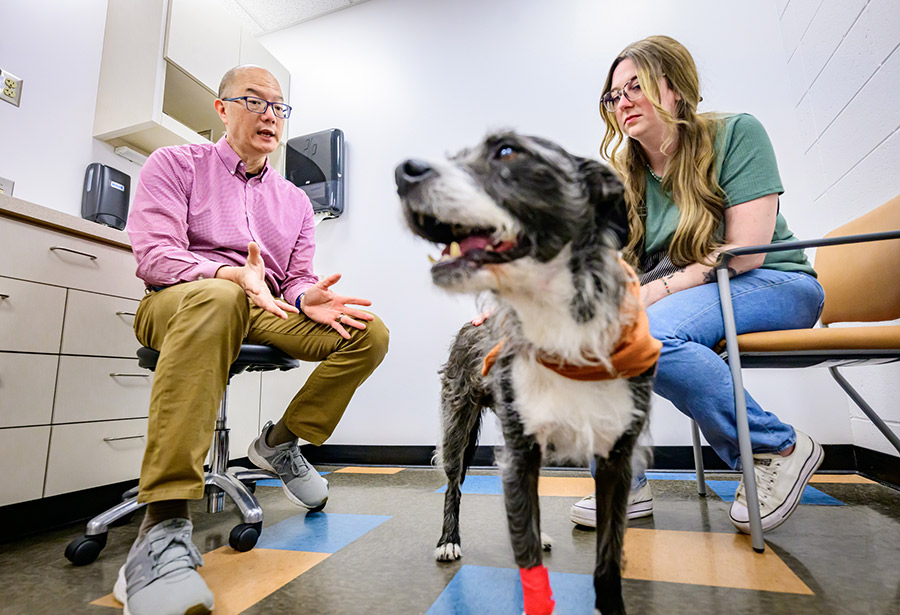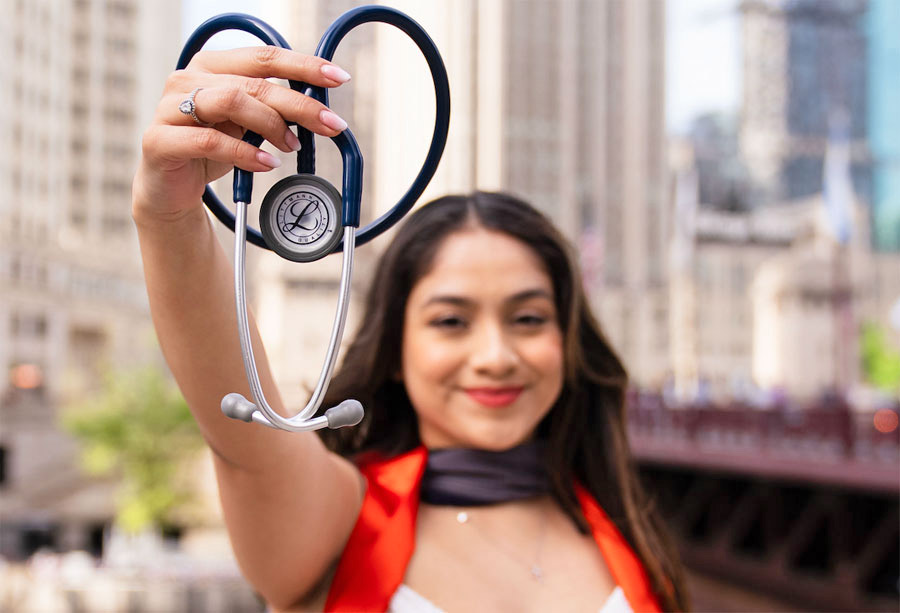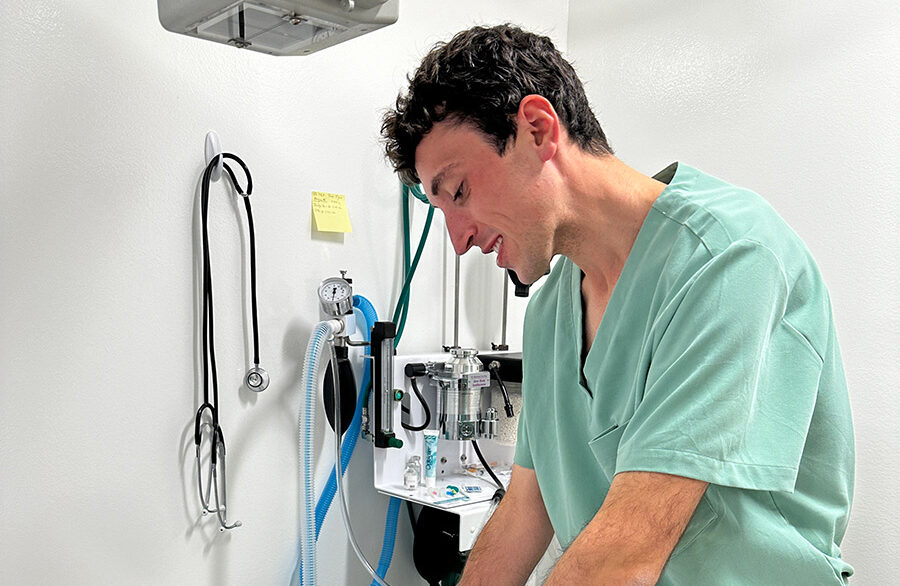Past Wildlife Patients
The University of Illinois Wildlife Medical Clinic—a non-profit organization that provides care and treatment to sick, injured, and orphaned wild animals—has featured a different patient almost every week on the Critter Cam since July 2016. Here is our archive of patients.
Check out this week’s featured animal on the Critter Cam
Juvenile Bald Eagle
![[juvenile bald eagle]](https://vetmed.illinois.edu/wp-content/uploads/2021/04/cc-juv-eagle-300x180.jpg) Update: Our juvenile bald eagle is back in good health and no injuries were found on radiographs, so he has been sent to the Illinois Raptor Center for flight conditioning. As soon as they are confident he can fly and hunt on his own, he will be released in the area where he was found!
Update: Our juvenile bald eagle is back in good health and no injuries were found on radiographs, so he has been sent to the Illinois Raptor Center for flight conditioning. As soon as they are confident he can fly and hunt on his own, he will be released in the area where he was found!
If you’re wondering why he doesn’t look quite like a typical image of a bald eagle, it’s because he is a baby. Juvenile bald eagles have dark beaks and entirely brown heads and bodies, with white and brown mottled wings and tails. As they get older, they start getting more white on their heads and tails, and their beaks become yellow.
This guy came to us because he was very weak and could not fly. We found that he was extremely thin and lethargic. After a couple of days of supportive care with fluids and tube feeding, he perked up significantly and began eating a ton of food on his own! He had a heavy load of gastrointestinal parasites, which we are currently treating, but no other problems that we could find. Since he is very young he may have not been hunting and feeding himself well, which sometimes happens with immature eagles. We are in the process of getting him up to a good weight. He needs to be nice and healthy to be put under anesthesia so we can take some radiographs (x-rays) to check for any injuries. Hopefully we won’t find any issues and this guy can be on his way back out into the wild!
—Cassie Vespa, second-year veterinary student
Barred Owl
![[barred owl]](https://vetmed.illinois.edu/wp-content/uploads/2021/04/cc-barred-owl-03-2018-300x180.jpg) This barred owl came to us with a broken humerus and broken major and minor metacarpals on that wing (essentially the bird equivalents to your upper arm bone and your hand bones). We fixed the humerus fracture surgically with some pins and an external acrylic bar attached to the pins to keep them aligned and are keeping the metacarpal fractures aligned with a splint. In addition to his wing fractures, this poor owl also had an eye injury that did not improve despite our best efforts. Since we were not able to improve the eye injury and barred owls do not need both eyes to survive in the wild, we performed an evisceration of the eye. This surgery involved removing most of the injured eye, but leaving the underlying structure of it rather than removing the entire eyeball (a procedure called an enucleation). It is important to leave the underlying structure of the eye when removing owl eyes because the shape of an owl’s face helps it to hear properly, which is very important to its ability to hunt. Both surgeries went well, and we are hoping with some physical therapy and cage rest, this guy will eventually be out in the wild, even if he does look a little bit more like a pirate.
This barred owl came to us with a broken humerus and broken major and minor metacarpals on that wing (essentially the bird equivalents to your upper arm bone and your hand bones). We fixed the humerus fracture surgically with some pins and an external acrylic bar attached to the pins to keep them aligned and are keeping the metacarpal fractures aligned with a splint. In addition to his wing fractures, this poor owl also had an eye injury that did not improve despite our best efforts. Since we were not able to improve the eye injury and barred owls do not need both eyes to survive in the wild, we performed an evisceration of the eye. This surgery involved removing most of the injured eye, but leaving the underlying structure of it rather than removing the entire eyeball (a procedure called an enucleation). It is important to leave the underlying structure of the eye when removing owl eyes because the shape of an owl’s face helps it to hear properly, which is very important to its ability to hunt. Both surgeries went well, and we are hoping with some physical therapy and cage rest, this guy will eventually be out in the wild, even if he does look a little bit more like a pirate.
—Kara Hiebert, second-year veterinary student
Red-Tailed Hawk
![[Red-tailed Hawk on Critter Cam]](https://vetmed.illinois.edu/wp-content/uploads/2021/04/cc-rth-feb2018-300x180.jpg) Update: We transferred him to a rehabber for some continued healing and flight reconditioning. Hopefully he will be back out in the wild in no time.
Update: We transferred him to a rehabber for some continued healing and flight reconditioning. Hopefully he will be back out in the wild in no time.
This week on the Critter Cam we’re featuring a red-tailed hawk that was brought into the Wildlife Medical Clinic after being found unable to fly away. During initial exam, the only obvious problems that we found were dehydration and anemia (lower than normal red blood cells). We then took some radiographs, or X-rays, and found that this little guy has a fractured right coracoid. The coracoid is a bone in bird shoulders that is sort of a strut supporting the shoulder and anchoring it to the top of the keel, which is similar to a sternum. Due to the location of this bone, it is very difficult to perform surgery on. This means we’ll need to keep this bird’s wing in a figure 8 and body wrap to keep the fracture stable until it heals. In the meantime, we’ll continue to keep an eye on this guy’s bloodwork to make sure the anemia continues to improve. He is feisty, so we have our fingers crossed that he will make a full recovery. On a side note, you might notice that this red tailed hawk’s coloring is much darker than most of the red tailed hawks that we have featured in the past. This is because red tailed hawks have multiple different color morphs, and this guy is a dark morph, which is one of the color morphs we don’t see very frequently.
—Kara Hiebert, second-year veterinary student
Barred Owl
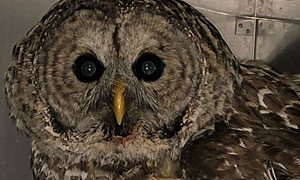 Update on Feb. 21: The barred owl continues to do well. We’re continuing physical therapy and will monitor his fracture healing with radiographs. Hopefully this time around he will heal up as planned!
Update on Feb. 21: The barred owl continues to do well. We’re continuing physical therapy and will monitor his fracture healing with radiographs. Hopefully this time around he will heal up as planned!
Update on Feb. 14: We took this guy’s pins out a week ago, and the fracture was still unstable (darn!). On Monday, we performed a second surgery to realign the fracture and “freshen up” the fracture site. His surgery went well, but unfortunately this means this little owl has to extend his stay with us for a few more weeks.
Since things are pretty slow in the Wildlife Medical Clinic due to the weather, we’re experiencing a little deja vu this week on the Critter Cam. The barred owl that is featured is actually the same one we previously had on the Critter Cam. He is still doing well and it has now been six weeks since we repaired his fracture. Normally, bird fractures heal enough for us to remove their hardware in three to four weeks. For some reason, though, this bird’s fracture hasn’t been showing obvious signs of healing during our re-check radiographs (x-rays). We will remove the hardware this week and if the humerus is stable he’ll be on his way to recovery. If the humerus is not stable, we’ll have to perform another surgery, and hopefully the second attempt will do the trick. We have our fingers crossed, though, that the humerus will be stable despite what it looked like on radiographs and that a second surgery won’t be necessary. Make sure you think good thoughts for this bird, and hopefully he’ll be ready to be sent to a rehabber for flight conditioning soon!
—Kara Hiebert, second-year veterinary student
Red-Shouldered Hawk
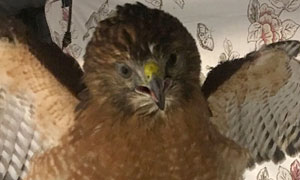 Update: This patient healed up and was very bright and active, so we sent him to a licensed rehabilitator to build up some flight muscles again. Hopefully he’ll continue to do well and will be back out in the wild in no time.
Update: This patient healed up and was very bright and active, so we sent him to a licensed rehabilitator to build up some flight muscles again. Hopefully he’ll continue to do well and will be back out in the wild in no time.
This week on the Critter Cam we have a red-shouldered hawk that was admitted to our clinic with an old radius and ulna fracture. This hawk’s fracture had actually started to heal, but unfortunately the bones were not aligned correctly. This meant we had to do surgery to break down the bony callus that had formed and realign the radius and ulna using metal pins and an external fixator. This particular fracture took longer to heal than usual, partially due to the chronic nature of the initial fracture, and partially due to an infection that had developed at one of the pin sites. We took some samples of the infection and switched up the antibiotics we were using and luckily, the infection has resolved and the bones have healed well, so we were able to remove this hawk’s hardware. Throughout this patient’s stay we have been performing physical therapy and laser therapy, and now that the hardware has been removed, we’re giving this hawk some space to spread its wings. Hopefully in the next week or two we can discontinue pain medication and send this hawk to a licensed rehabilitator for flight reconditioning.
—Kara Hiebert, second-year veterinary student
Barred Owl
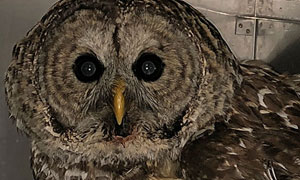 Update: The barred owl is still doing well under our care. The humerus has not healed quite enough for us to remove the hardware, but we will take more radiographs (x-rays) in a week or so to check again. Hopefully this bird will be on its way to flight reconditioning and then released soon!
Update: The barred owl is still doing well under our care. The humerus has not healed quite enough for us to remove the hardware, but we will take more radiographs (x-rays) in a week or so to check again. Hopefully this bird will be on its way to flight reconditioning and then released soon!
An adult barred owl was admitted to the Wildlife Medical Clinic after being found unable to fly. On physical examination, students found that this patient was suffering from an open fracture of his right humerus (bone between shoulder and elbow). A few days later, the patient had surgery to place pins and other hardware in order to properly align and stabilize the broken bone. The surgery went quite well and this patient has been on the road to recovery for about three weeks now! In his care here, he has received proper pain management, as well as an antibiotic to prevent any infection from developing. Additionally, we have been performing physical therapy on his joints and using a laser to help reduce inflammation and promote bone healing. Hopefully, in the next week or two, we can remove the hardware and send him to a wildlife rehabilitator for flight conditioning before release!
—Ainsley Boyle, third-year veterinary student
Eastern Screech Owl
![[Eastern screech owl]](https://vetmed.illinois.edu/wp-content/uploads/2021/04/cc-screech-owl-12-2017-300x180.jpg) Update: This patient is still in our care and we will be performing radiographs in the coming week to assess the bone healing.
Update: This patient is still in our care and we will be performing radiographs in the coming week to assess the bone healing.
This week the Critter Cam features an adult Eastern screech owl. The owl in this picture is considered to be a red morph (there are several different morphs, or colors, of this species). He presented to the clinic with fractures of both the radius and ulna of his left wing. Fortunately for this bird, he was able to be brought into surgery just a few days after intake to the clinic. A pin was placed in both the radius and ulna in order to stabilize the bones during the healing process. With some pain management and physical therapy, this patient is well on his way to recovery! In fact, radiographs (X-rays) are being taken to track the progress of the healing ulna, and we are hoping to remove the hardware from his wing in the near future! You may notice the strips of newspaper hanging around the cage; this provides some enrichment for the patient while he is in captivity with us. Owls are nocturnal species, so keep an eye on this guy in the late hours of the night because he will likely be more active!
—Ainsley Boyle, third-year veterinary student
Juvenile Red-Tailed Hawk
![[critter cam - juvenile red-tailed hawk]](https://vetmed.illinois.edu/wp-content/uploads/2021/04/cc-rthawk-12-17-300x180.jpg) Update: This patient has been transferred to a wildlife rehabilitator for flight conditioning before release!
Update: This patient has been transferred to a wildlife rehabilitator for flight conditioning before release!
This week, our camera is focused on a juvenile red-tailed hawk. He was found on the side of the road and brought to a referring veterinarian. Radiographs (x-rays) were taken, which showed several metal pellets around the body, as well as a fractured ulna (bone of the forearm). The hawk was transferred to the Wildlife Medical Clinic where we further assessed his injuries. He underwent surgery to remove fragments of the metal pellets from the fracture site and his wing was kept bandaged for about three weeks in order for bone healing and stabilization to occur.
Fortunately, this patient is doing very well and seems to be healing nicely! The wing wrap was removed about a week ago and he was moved to a larger space in order to start using his wings more. We are hoping to send this guy off to rehab for flight conditioning in the next week or two. Like many of our red-tailed hawk patients, this feathery friend is quite enthusiastic about mealtime. Try to tune in to watch him receive his breakfast in the morning!
—Ainsley Boyle, third-year veterinary student
Peregrine Falcon
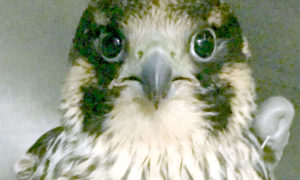 Update: The peregrine falcon was transferred to a wildlife rehabilitator for flight conditioning!
Update: The peregrine falcon was transferred to a wildlife rehabilitator for flight conditioning!
This week’s Critter Cam features a pretty rare species for the Wildlife Medical Clinic: a peregrine falcon. Peregrine falcons are some of the fastest fliers around the world. They tend to catch birds out of the air while in flight, and they may reach speeds as fast as 200 mph in pursuit of their prey!
The falcon in our care was transferred to us from a local wildlife rehabilitator after after the bird had been hit by a car. She was diagnosed with a fractured humerus and a fractured radius (the smaller bone in a bird’s “forearm”). She underwent surgery to correct both the humerus and the radius. Thankfully, the radius fracture was pretty well aligned and the metal pin was removed after about two weeks. She still has some pins with an acrylic bar to keep the humerus stable while the bone heals. We’re about three weeks out of surgery, and hopefully we will be able to remove the pins in the next week or two! This patient is quite vocal, and although you will not be able to hear her squawking, you may be able to see her opening her mouth to “yell” at us!
—Ainsley Boyle, third-year veterinary student
Short-Eared Owl
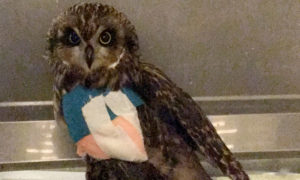 Update: Sadly, the short-eared owl died unexpectedly.
Update: Sadly, the short-eared owl died unexpectedly.
This week on the Critter Cam, we are featuring a species that we don’t see very commonly in the clinic—a short-eared owl. These owls are much smaller than great horned owls or long-eared owls and live primarily out on the prairie rather than forested areas.
This particular short-eared owl came to us last week with a fractured humerus (the upper “arm” bone in the wing). Since this fracture was open (the bone had pierced the skin), and the bone ends were not aligned well, we needed to surgically repair it. This little owl was taken into surgery and the fracture was repaired using metal pins with an external acrylic fixator. This fixator will basically act as a cast that is anchored to the bone to keep it as stable as possible. You’ll probably noticed this large grey fixator poking out of his bandage at his shoulder.
Unfortunately, this owl’s fracture was pretty gnarly and the repair was difficult, so he’s got a long road ahead. After a little while of keeping the wing bandaged up, we’ll start performing some passive range of motion by extending and flexing the elbow and shoulder to prevent too much loss of movement. Hopefully some pain medication, antibiotics, and a little peace and quiet will help this little guy make a full recovery.
—Kara Hiebert, second-year veterinary student
Red-Tailed Hawk
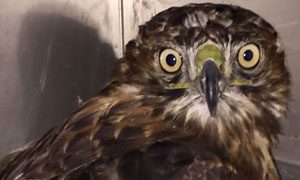
For now, we are doing our best to plump him up to help him regain his strength! There were some abnormal cells on his last round of bloodwork, so we are monitoring him for any changes in behavior or appetite. You may notice that this bird has something on his tail. It is what we call a tail guard. Tail feathers are very important for flight once our patients are releasable, so we try to protect their tail feathers as much as possible. We use a piece of x-ray film and feather-safe tape to make the guard!
Red-tailed hawks are probably the most common species we see here in the WMC (maybe besides Eastern cottontails!). They are commonly seen soaring up above or perching on road signs, fenceposts, or telephone poles. Red-tailed hawks develop their reddish-brown colored tail at the age of two or three years, which is how we are able to classify this critter as an adult.
—Ainsley Boyle, third-year veterinary student
Juvenile Opossum
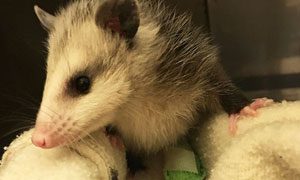
—Kara Hiebert, second-year veterinary student
Eastern Gray Squirrels
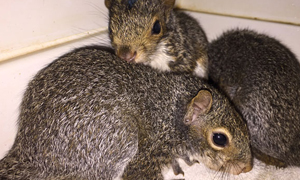 Update: The young squirrels continue to do well, and are ready to be transferred to a rehabilitator to learn essential skills before being released into the wild.
Update: The young squirrels continue to do well, and are ready to be transferred to a rehabilitator to learn essential skills before being released into the wild.
This week on the Wildlife Medical Clinic’s Critter Cam is a group of Eastern gray squirrels. They are estimated to be about six to seven weeks old at this point. The majority of these patients were brought in because they were found in a cut-down tree (a common occurrence around this time of year in the clinic). There is one little guy in this cage who suffered a tail injury, so you may be able to tell which one of them has a shorter tail than the rest.
—Ainsley Boyle, third-year veterinary student
Red-Tailed Hawk
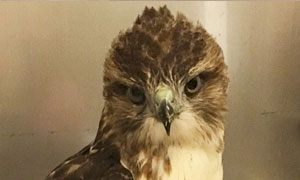 Update: The red-tailed hawk is continuing to heal well and should hopefully have his surgical pins removed shortly!
Update: The red-tailed hawk is continuing to heal well and should hopefully have his surgical pins removed shortly!
Our Critter Cam was MIA for a few days while we were busy moving our clinic to a new, larger space, but we are happy to say that the move went smoothly and the Critter Cam is up and running again! This week we are featuring a red-tailed hawk that has a broken wing (more specifically, his humerus). This little guy was originally brought to the Illinois Raptor Center and then they were able to transport him to us for the medical care he needs. After our initial exam, we took radiographs (x-rays) of his wing to see exactly where his fracture was and decide how to fix it. We fixed this fracture surgically with pins and an external acrylic fixator, so this guy has some extra hardware for the time being. Now, we just need to wait until the bone has healed enough to take the pins out. Once we take those out, this hawk can be sent to a rehabilitator for some flight reconditioning before hopefully returning to the wild.
—Kara Hiebert, second-year veterinary student
Canada Goose
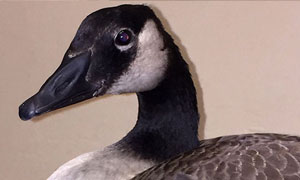 Update: The goose’s leg healed well, and since he was able to walk and swim properly, he was released where he was found.
Update: The goose’s leg healed well, and since he was able to walk and swim properly, he was released where he was found.
This week’s Critter Cam features an adult Canada goose. This critter presented to the clinic a few weeks ago with a fractured tarsometatarsus (the bone between a bird’s “knee” and “ankle”). He underwent surgery in order to realign the bone, and pins were placed through the bone in order to hold it in the correct alignment during the healing process. Within 24 hours of surgery, the goose was up, walking around, and using his broken leg. With some pain management and physical therapy in his swimming pool, this patient is well on his road to recovery! In hopefully a week or two, we will be able to remove the pins and he can be transferred to a rehabilitator before being released back out into the wild! You’ll most likely catch this guy spending most of his time standing at the top of the ramp or swimming in the pool!
—Ainsley Boyle, third-year veterinary student
American Robin
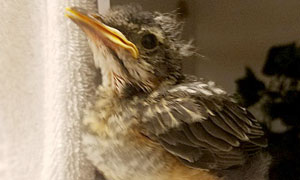 Update: The fledgling robin was transferred to a licensed rehabilitator where he will learn to forage and fly before being released into the wild on his own!
Update: The fledgling robin was transferred to a licensed rehabilitator where he will learn to forage and fly before being released into the wild on his own!
Many species of song birds nest each year in Central Illinois, raising clutches of young that go through stages of maturation. Nestling birds remain in the nest under the tireless care of their parents, having food brought to them from dawn to dusk. Many nestling birds are fed as frequently as every 10 to 15 minutes during the day. Once mature feathers replace the downy fluff of the nestlings, these young become “branchers,” venturing from the nest to perch on nearby branches as they stretch their legs and wings.
A short time later, the branchers fledge from their nest site and become fledglings. Fledgling birds are learning to fly and find food while still under the watchful eyes of their parents. Parent passerines bring food to their young during this time and will do what they can to protect their young from harm. A fledgling bird may appear to be unable to fly, but these birds truly do not need to be “rescued.” If you watch the bird for a while, you may see its parent come feed it and hear as it calls for its next meal.
This American robin is at the awkward in-between stage between brancher and fledgling. It is healthy but still needs to be fed while it learns to eat on its own. American robins can be found most of the year in Central Illinois but migrate to warmer climates during the late fall and winter.
—Dr. Julia Whittington, Wildlife Medical Clinic Director
Turkey Vulture
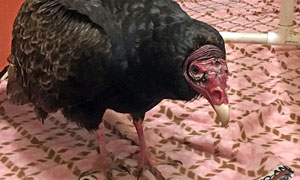 Update: The turkey vulture is doing well. X-rays show that the fracture is aligned and the healing process is progressing. We will recheck x-rays again in about three weeks.
Update: The turkey vulture is doing well. X-rays show that the fracture is aligned and the healing process is progressing. We will recheck x-rays again in about three weeks.
This week on the Critter Cam we’re featuring a turkey vulture that is recovering from a broken humerus. This guy came in over a month ago, and it was clear he couldn’t fly and hadn’t eaten in a very long time. We tube fed him so that he could build up some more muscle, and once he was stable enough, we took some radiographs (x-rays). We found an old humerus (a bone in the wing) fracture along with over 20 little metallic balls that looked a whole lot like bullets. Luckily, the bullets hadn’t hit any joints, so this guy’s main problem was his broken humerus. Just last week, we surgically repaired the humerus with pins and an external acrylic fixator (the big gray structure that can be seen on his left wing). We hope that, with some time and physical therapy, this vulture will be soaring back out in the wild again.
Remember, if you’re ever tempted to shoot these birds, vultures are scavengers that only eat dead animals, which helps prevent the spread of many diseases throughout our environment. Please leave these birds be and let them do their job to make our ecosystem cleaner.
—Kara Hiebert, second-year veterinary student
Blue Jay & American Robin
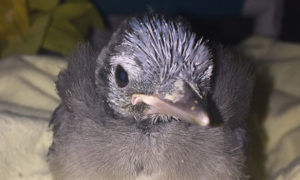 Update: The robin has been transferred to a rehabilitator until he is ready to be released. Unfortunately, the blue jay died unexpectedly.
Update: The robin has been transferred to a rehabilitator until he is ready to be released. Unfortunately, the blue jay died unexpectedly.
Featured on the Wildlife Medical Clinic’s Critter Cam this week is a cage with two fledgling birds: one blue jay and one American robin. The clinic has seen many young birds, ranging from nestlings to fledglings, in the past couple months, but we are starting to see more of the fledglings who are still trying to figure out how to fly! The blue jay was found abandoned in a yard, while the American robin was found in a bush that had been trimmed and the nest was destroyed in the process. Fortunately, both of these little guys seem to be completely healthy (with great appetites!), so we are providing regular feedings until they are able to be transferred to a licensed wildlife rehabilitator!
—Ainsley Boyle, second-year veterinary student
American Kestrel
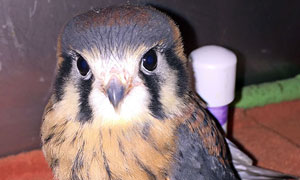 Update: The American kestrel is doing well and should hopefully be released this weekend!
Update: The American kestrel is doing well and should hopefully be released this weekend!
Our camera has been fixed! This week we are featuring an American kestrel that was brought to our clinic on June 18. He was found in the middle of a road and would not fly away. During our physical exam we didn’t find any issues with his muscular or skeletal system, but he was swaying some while perching and acting more “dumpy” than a healthy kestrel should during handling. He looked as if he just wasn’t feeling well, so we drew some blood to test his chemistries and get a complete blood count. The results of these tests showed that he had an abnormally high number of lymphocytes (a type of white blood cell), which indicates that he is fighting some sort of infection. Right now, he’s on an antibiotic and seems to be perking up. Hopefully he’ll be healthy enough to be released back to the wild in the near future.
—Kara Hiebert, second-year veterinary student
Coyote Pup
![[critter cam - coyote pup]](https://vetmed.illinois.edu/wp-content/uploads/2021/04/cc-coyote-pup-300x180.jpg) Update: The coyote pup was transferred to a local rehabilitator to continue his cage rest with the company of some other coyote pups. As much as we enjoyed how cute he was, if we had kept him away from other coyotes much longer, he would have become too accustomed to humans to be released into the wild.
Update: The coyote pup was transferred to a local rehabilitator to continue his cage rest with the company of some other coyote pups. As much as we enjoyed how cute he was, if we had kept him away from other coyotes much longer, he would have become too accustomed to humans to be released into the wild.
This coyote pup came to the Wildlife Medical Clinic after being hit by a car the night of May 25. Our wonderful ER staff took care of him overnight and started him on some IV fluids before we took over in the morning. When he first came to us, he was pretty down and out, but after rehydration and some pain medications, he perked right up. The day after he came in, we took radiographs (x-rays) of him and found that he has a broken pelvis, but didn’t see any other issues on the images. For this injury, we think some cage rest and a little physical therapy might just do the trick to get this little guy healed up.
—Kara Hiebert, second-year veterinary student
Juvenile Red-Tailed Hawk
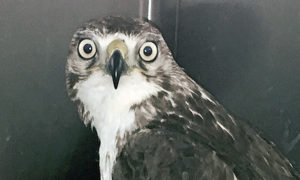
Update: On re-check radiographs, the hawk’s fracture appears to be healing well. We’ll be sending him to a local rehabilitator soon for flight conditioning.
Featured this week on the Critter Cam is a juvenile red-tailed hawk in the Wildlife Medical Clinic. This critter was found in a cornfield unable to fly. The finder brought him to a raptor rehabilitator, who then transferred the hawk to us for medical treatment. On radiographs (x-rays), it appears that this little guy has a fractured major metacarpal (bone associated with the wrist). Our plan is to keep the wing bandaged and stable for a few weeks, along with providing physical therapy exercises, before transferring him back to the rehabilitation center for flight conditioning. We medicate his mice twice a day, so keep an eye out during feeding time!
—Ainsley Boyle, second-year veterinary student
[toggleset][toggle]
Critter Cam Patients Before October 2017
Ducklings
![[cc-duckling]](https://vetmed.illinois.edu/wp-content/uploads/2021/04/cc-duckling-300x181.jpg)
Update: The ducklings were transferred to a rehabber. After they grow up, they will be released in the wild.
Caught on the camera this week is a group of Mallard ducklings! These little guys were brought in after being found in a restaurant’s parking lot, alone without their mom. Ducks are precocial animals, meaning that as soon as they are hatched, their eyes are open and they are able to walk around and feed for themselves. Even though they are able to find food themselves, they are still too little and young at this age to be out in the wild by themselves. Fortunately, these ducklings seem healthy and will hopefully be transferred to a licensed wildlife rehabilitator soon!
You may notice that there is a larger patient in the same tub as the ducklings—this is a gosling (young Canada goose). He was brought in with a sibling, who unfortunately did not make it. Instead of keeping the gosling alone, we placed him in the same tub as the ducklings so he could have some company before being released back into the wild with his family!
—Ainsley Boyle, second-year veterinary student
Raccoons
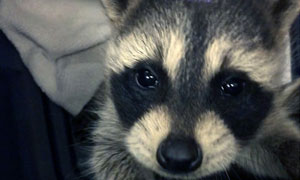
Update: We had to move the camera off the raccoon kits because they kept knocking it down!
Now featured on the Critter Cam are six orphaned raccoon kits. They are estimated to be three to four weeks of age. They were all found in a home and the mother had not been spotted for a couple days. With some species, babies that are four weeks old are able to be out on their own and able to find food, but in this case, it was the right thing to bring them in for help. Fortunately, these raccoons are healthy and thriving in our care! You may notice that each raccoon has a color on the top of its head. We use different colors of nail polish in order to tell the difference between animals in a litter!
Wild baby animals ALWAYS do better with their mom than in the care of humans. Unless the animal is clearly injured or you know that the mother is dead, please call your local wildlife rehabilitator for advice before “rescuing” them, because in most cases, babies are not actually orphaned.
—Ainsley Boyle, second-year veterinary student
Gray Squirrels
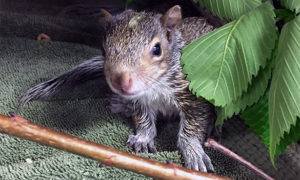 Update: Less than 24 hours after the camera focused on our two squirrels, we had a surprise visitor from a wildlife rehabilitator, who took them to her facility!
Update: Less than 24 hours after the camera focused on our two squirrels, we had a surprise visitor from a wildlife rehabilitator, who took them to her facility!
This week on the Wildlife Medical Clinic’s Critter Cam are two juvenile Eastern gray squirrels. We are estimating that they are about 6 to 7 weeks old. These patients were brought to the clinic after falling from their nest on a roof. The finders thought that the squirrels were injured from the long fall, which is why they were brought in. Fortunately, these two little critters seem to be totally healthy and do not seem to have been affected by the fall!
We have placed branches in order to allow the young squirrels some enrichment while in our care. They are syringe fed formula twice a day, but you can catch them nibbling on some softened foods throughout the day! Keep on eye to watch them snuggled up with one another or acting squirrely while climbing around their cage!
—Ainsley Boyle, second-year veterinary student
Pied-Billed Grebe
![[critter cam - pied-billed grebe]](https://vetmed.illinois.edu/wp-content/uploads/2021/04/cc-grebe-300x180.jpg) Update: Sadly, the grebe died unexpectedly.
Update: Sadly, the grebe died unexpectedly.
This juvenile pied-billed grebe was found with an injured wing and was promptly brought to the clinic by a good Samaritan. During the initial physical exam, our volunteers found a fairly large soft tissue wound over this patient’s right radius and ulna. Luckily, all of the bones and ligaments of that wing felt intact and no other major problems were found. We are managing this little guy’s wound by keeping it bandaged and applying topical ointment to promote healing. We’re also giving him a round of antibiotics to ensure that he does not develop an infection from the wound. Since pied billed grebes are waterfowl, we needed to use waterproof bandaging material and provide a swimming area so this patient can maintain his feather quality. We also soon figured out that this grebe is a picky little guy, since he turned up his bill to the frozen fish we initially offered. Turns out, he is only willing to eat live fish, so if you tune in during the morning or evening you may catch a glimpse of him chasing after them.
—Kara Hiebert, first-year veterinary student
Juvenile Red Fox
![[critter cam - red fox kit]](https://vetmed.illinois.edu/wp-content/uploads/2021/04/cc-fox2-300x180.jpg) Update: : The fox kit’s tail surgery site was healing well and she continued to use her front leg correctly, so she was sent to a local rehabilitator to prepare for release back into the wild.
Update: : The fox kit’s tail surgery site was healing well and she continued to use her front leg correctly, so she was sent to a local rehabilitator to prepare for release back into the wild.
Featured on the Wildlife Medical Clinic’s Critter Cam this week is a female juvenile red fox. This girl was transferred to the clinic from a local licensed wildlife rehabilitator. During her initial physical examination, volunteers noticed that her front right paw was not in the proper position when she walked and stood in the cage. Radiographs (x-rays) showed a fractured radius (bone of the forearm). Thankfully, the bone was well aligned and the ulna was intact to act as a splint, so she did not need surgery. We placed a metal splint and kept the leg bandaged for five days, while providing pain management and cage rest. Since she is otherwise a young, healthy fox kit, her fracture became stable enough and after five days, she was able to ambulate appropriately without the splint on!
Additionally, this little fox came in with a partially amputated tail that developed an abscess. Therefore, we surgically amputated the most distal (farthest from the body) aspect of her tail. To keep her from chewing on the bandage, you can see her wearing a soft cone. Since foxes are nocturnal animals, don’t be surprised to see her the most active at night!
—Ainsley Boyle, second-year veterinary student
Raccoon Kits
![[critter cam - orphaned raccoon]](https://vetmed.illinois.edu/wp-content/uploads/2021/04/cc-raccoon-orphan-300x180.jpg) It’s baby season! On camera this week is a litter of four orphaned raccoon kits. These little guys were brought in to the Wildlife Medical Clinic after they were found alone with no mom in sight. Raccoon kits are too young to be without mom at this age—their eyes and ears are both still closed. They are helpless on their own, so rescuing them was the right thing to do in this case. Sometimes though, baby animals can be found alone and be completely fine. Young rabbits and deer are great examples of animals who naturally spend many hours a day alone. Mom leaves the babies hidden to try to keep predators away and only returns to them a few times a day to feed them.
It’s baby season! On camera this week is a litter of four orphaned raccoon kits. These little guys were brought in to the Wildlife Medical Clinic after they were found alone with no mom in sight. Raccoon kits are too young to be without mom at this age—their eyes and ears are both still closed. They are helpless on their own, so rescuing them was the right thing to do in this case. Sometimes though, baby animals can be found alone and be completely fine. Young rabbits and deer are great examples of animals who naturally spend many hours a day alone. Mom leaves the babies hidden to try to keep predators away and only returns to them a few times a day to feed them.
Wild babies ALWAYS do better with mom to raise them, so unless the animal is obviously injured or sick or you see a dead mother or siblings nearby, call a wildlife professional for help before “rescuing” them, and help us give these animals their best chance at a wild life!
—Dr. Nicki Rosenhagen
Bald Eagle
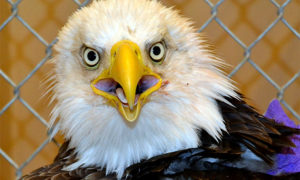 Update: The bald eagle continues to do well. He will have repeat x-rays this week to monitor the healing of his humerus and should be ready to start using the wing in another couple of weeks.
Update: The bald eagle continues to do well. He will have repeat x-rays this week to monitor the healing of his humerus and should be ready to start using the wing in another couple of weeks.
The Wildlife Medical Clinic’s Critter Cam is keeping an eye on an adult male bald eagle this week. This patient arrived with a broken humerus (the bone between the shoulder and elbow). Often, wild birds with broken bones are too small to handle the relatively heavy implants used in domestic animal medicine. However, eagles are large enough that those implants may afford the best chance of recovery. So, with the help of the orthopedic surgeons, the doctors repaired the fractured bone using a metal plate and 10 small screws. The benefit to this type of repair is that the hardware used to repair the bone is completely covered by the skin, meaning there are no pins sticking out of the bone as is often the case with fracture repairs in smaller species. This decreases the chance of infection and additional injury to the wing. So far, the eagle seems to be doing well. He has a great appetite and attitude and, while he’s still quite bruised and sore from surgery, the x-rays look very promising for a full recovery!
—Dr. Nicki Rosenhagen
Cooper’s Hawk
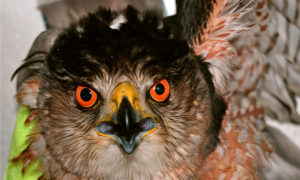 Update: The Cooper’s hawk is still recovering. The broken bone fragments did extensive damage to the surrounding skin and muscle, so we’re managing those wounds to the best of our ability. Fortunately, the bone itself is healing nicely!
Update: The Cooper’s hawk is still recovering. The broken bone fragments did extensive damage to the surrounding skin and muscle, so we’re managing those wounds to the best of our ability. Fortunately, the bone itself is healing nicely!
This male Cooper’s hawk was brought to the Wildlife Medical Clinic unable to fly. A physical exam and x-rays revealed not only a broken wing but also evidence of metal in his gastrointestinal tract. The presence of metal in the GI tract of an animal is problematic because some metals, like lead and zinc, can be toxic to animals if they are in an acidic environment (like the stomach). Unfortunately, a blood lead test confirmed toxic levels, so this bird is fighting the effects of a broken bone AND a toxicity. The good news is that despite the high levels of lead in his blood, he’s not displaying any of the classic neurologic signs we associate with lead toxicity. On Monday, we took this bird to surgery and repaired the broken wing, and he’ll receive treatment to rid his body of the toxic metal. With any luck, this bird is on the road to recovery and may just get a second chance at a wild life this summer.
—Dr. Nicki Rosenhagen
Eastern Box Turtle
![[critter cam - eastern box turtle]](https://vetmed.illinois.edu/wp-content/uploads/2021/04/cc-box-turtle-300x180.jpg) Update: The turtle is doing well. Turtles move at their own (very slow) pace, so when she lets us know she’s ready, we’ll start incorporating her into our education program.
Update: The turtle is doing well. Turtles move at their own (very slow) pace, so when she lets us know she’s ready, we’ll start incorporating her into our education program.
Sadly, this little lady was taken from her wild home several years ago and kept as a pet. During her time in captivity, she subsisted on a poor diet of exclusively mealworms and canned mandarin oranges and was deprived of the correct lighting for normal bone development. This inadequate husbandry led to several negative changes in her body, and when she finally presented to the Wildlife Medical Clinic after she was no longer wanted, she had shell abnormalities and bony deformities in her front legs.
Unfortunately, because of both her injuries and her friendly demeanor, she is not a candidate for release back into the wild. But the good news is that the Wildlife Medical Clinic has been looking for more reptiles to serve as education animals, and she fits the bill! She’s doing well on a balanced diet with appropriate lighting, and as soon as she’s healthy, she’ll join the ranks of River the bald eagle, Odin the red-tailed hawk, and Onslo the blue-tongued skink to educate members of the community about wildlife and, especially in her case, why wild animals do not make good pets. We’re excited to have her!
—Dr. Nicki Rosenhagen
Editor’s note: The College of Veterinary Medicine is home to one of the foremost laboratories studying the eastern box turtle. Every year Dr. Matt Allender conducts a health assessment of this species in Illinois and Tennessee, with the help of special turtle-detecting dogs. For details, see his lab’s website or watch the video.
Barred Owl
![[critter cam - barred owl]](https://vetmed.illinois.edu/wp-content/uploads/2021/04/cc-barred-owl-3-17-300x180.jpg) Update: Within a few days of her debut on Critter Cam, the barred owl was ready to go! She’s being flight tested with the folks at the Illinois Raptor Center with the hope she can be released soon.
Update: Within a few days of her debut on Critter Cam, the barred owl was ready to go! She’s being flight tested with the folks at the Illinois Raptor Center with the hope she can be released soon.
This week’s Critter Cam is focused on another beautiful barred owl! This girl was found in the woods in Tuscola, Ill., on the ground and unable to fly. On examination, the students identified an abnormal right wing but were unable to determine exactly what was wrong. The following day, a radiograph revealed an old, healing fracture of her right humerus (bone between the shoulder and elbow). After consultation with the doctors, the students decided to manage their patient by keeping her quiet, managing her pain, and allowing her wing to finish healing naturally rather than undertaking an aggressive surgery. Because the bone has been healing in the wild, it was not aligned and immobilized as well as if she had been in a hospital. So, while we don’t know if the altered position of the bone will allow her to fly in the future, physical therapy and time will give her the best chance of healing and returning to her wild home. To provide enrichment, the students have been hiding her food in toys and paper towel rolls, so be on the look-out for some in-cage hunting!
—Dr. Nicki Rosenhagen
American Kestrel
![[critter cam - American kestrel]](https://vetmed.illinois.edu/wp-content/uploads/2021/04/cc-amkestrel-300x180.jpg) Update: The American kestrel healed well and has been transferred to the rehabilitator for flight conditioning!
Update: The American kestrel healed well and has been transferred to the rehabilitator for flight conditioning!
In the spotlight this week is an adult male American kestrel. This little spitfire of a bird presented with a broken wing, and though the students were able to identify the fracture on their physical exam, an x-ray picked up on another injury that is much more difficult to spot. This poor guy is suffering from a fractured ulna (in a person, this is the bone that extends from the pinky finger to the elbow) AND a fractured coracoid. A coracoid is a unique bone in birds and one that mammals, like cats and dogs, do not have. It’s near the clavicle (or wishbone) and is an important bone for flight. Unfortunately, its location in the body makes it a common victim of injury when a bird colloids with or gets hit by something. To manage these injuries, time is often the best medicine, so we’re hoping to just keep him in a wrap (like a sling) and allow time to do its job. He’s receiving regular physical therapy and will have repeat x-rays to check his progress next week.
—Dr. Nicki Rosenhagen
Long-eared Owl
![[critter cam - long-eared owl]](https://vetmed.illinois.edu/wp-content/uploads/2021/04/cc-long-ear-owl-300x180.jpg) Update: We are sad to report that, unfortunately, despite very extensive efforts, the long-eared owl did succumb to his injuries.
Update: We are sad to report that, unfortunately, despite very extensive efforts, the long-eared owl did succumb to his injuries.
This week the critter cam is focused on a long-eared owl. Long-eared owls are actually quite common in Illinois, but the Wildlife Medical Clinic has only ever cared for a handful of them in its history, so we were excited to have the opportunity to work with this amazing species.
This owl presented with a fractured humerus (upper-arm bone), and when the students took radiographs, they realized that it was broken in several places. After a couple of days to make sure he was strong enough for surgery, we put this bird under anesthesia and placed pins to re-align the bone. The surgery was fairly tricky – these are pretty small owls (only 300 grams!), the bone was in more pieces than we could appreciate on the x-ray and the radial nerve (a very important structure for wing function) was crossing over one of the fracture sites. Fortunately, the post-operative x-rays show that the alignment is rather good, so now we have to wait and see if the nerve is still functional. To give this bird his best shot, the students are managing his pain, controlling for infection, warming the wing to encourage blood flow, and using a low-level laser to encourage healing. We should have an idea on his prognosis in another week or so!
—Dr. Nicki Rosenhagen
Juvenile Red-Tailed Hawk
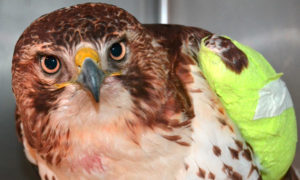
Update: The red-tailed hawk is doing very well. She’ll have radiographs taken this week, and if the fracture site looks and feels stable, we’ll be sending her to a rehabilitator for pre-release conditioning!
Featured on the Wildlife Medical Clinic’s Critter Cam this week is a juvenile red-tailed hawk. This young bird was brought to us by a local animal lover who noticed that the bird had been down on the ground for several days. On examination, the students noted that there was a significant amount of bruising all along the left wing, and with the help of an x-ray, they were able to diagnose a fractured ulna.
Fortunately, the fracture is closed (meaning the bone shards didn’t penetrate through the muscle and skin), and the radius (the other long bone next to the ulna in the forearm) is still intact. An intact radius makes our job much easier because it acts as an internal splint, and often, we don’t even need to surgically correct the broken ulna, as is the case for this animal. The pieces of the ulna in this bird are fairly well-aligned, so we are managing this injury with an external splint (called a figure-of-8 bandage) to keep the wing immobilized.
She’ll receive pain medication for another week or so and then start some gentle physical therapy to keep the joints loose and working normally. With any luck, she’ll be on her way to the flight cage for conditioning before St. Patrick’s Day!
—Dr. Nicki Rosenhagen
Black Rat Snake
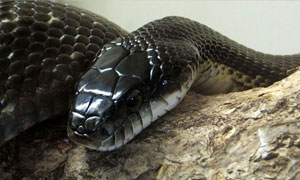 Update: The black rat snake is still in care, relaxing until the weather turns, but as soon as spring officially springs, he’ll be back out in the wild!
Update: The black rat snake is still in care, relaxing until the weather turns, but as soon as spring officially springs, he’ll be back out in the wild!
Featured on the Wildlife Medical Clinic’s Critter Cam is a black rat snake! This unique visitor to the clinic was brought in after he was found out in the cold this past December. Like other reptiles, snakes normally spend the winter hibernating until the warmer weather rolls around. However, if they are disturbed or become ill, they may be found out and about in dangerously cold temperatures. This snake appears to be healthy based on our physical exam and his behavior in captivity, so it seems likely his winter slumber was probably just disturbed.
Unfortunately, since the weather is still chilly, he’s going to be spending the rest of the season in the hospital with us. It’s not all bad though! This snake now gets to stay dry and warm with free food to boot. He spends most of his time buried beneath the mulch, but if you keep checking in, you may catch him out basking under the heat lamp or searching for that meal. Come springtime, this guy will be released back into the wild where he belongs.
—Dr. Nicki Rosenhagen
Juvenile Sharp-Shinned Hawk
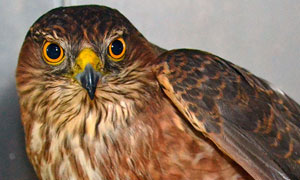 Update: The sharp-shinned hawk was successfully released after she recovered from her wing injury!
Update: The sharp-shinned hawk was successfully released after she recovered from her wing injury!
Featured this week is a juvenile sharp-shinned hawk. The Wildlife Medical Clinic often cares for the sharp-shinned hawk’s larger (almost identical) cousin, the Cooper’s hawk, but sharpies are a rare visitor to the clinic. Songbirds make up the majority of the sharp-shinned hawk’s diet, and the aerial pursuit during a hunt can be quite impressive. Unfortunately, where human and sharp-shinned hawk habitats overlap, windows can be a dangerous obstacle during these hunts, and this is precisely what happened to our patient. The finders witnessed the bird crashing into their window while trying to catch a meal, and while sometimes birds can recover quite quickly from this type of collision, this bird was not so lucky.
Based on physical exam and x-rays, there are no broken bones, but since he is still unable to fly, we’re managing this patient with cage rest and pain management in the hopes that the problem is related to muscle injury. So far, he seems to be making some improvements, so we’re optimistic about his future flight capabilities. Sharp-shinned hawks are very high energy animals, so he may be quite active on camera, even when no one is around!
—Dr. Nicki Rosenhagen
Eastern Screech Owl
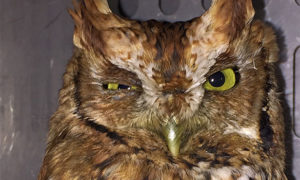 Update: The eastern screech owl was cleared by the ophthalmology department to discontinue her eye medications, so we’re weaning her off of those to see how she does. If all goes well, she’ll be leaving for the rehabilitator next week!
Update: The eastern screech owl was cleared by the ophthalmology department to discontinue her eye medications, so we’re weaning her off of those to see how she does. If all goes well, she’ll be leaving for the rehabilitator next week!
This week’s Critter Cam features an adult eastern screech owl. The owl you see here is considered a red morph (there are a few different colors of this species). This small owl was found on the side of the road in a nearby county and was rescued by a good Samaritan. On intake, the volunteers noted that she had blood in the back of one of her eyes, her head tilted to one side, and she was overall weak and not acting like a normal owl. All of these signs led the students to believe that she suffered from head trauma (swelling of the brain leading to these abnormal findings). After some fluid therapy and anti-inflammatory medications, this bird seems to be feeling much better! She hops around her cage and seems to have a much better appetite than when she came into the clinic. The Veterinary Teaching Hospital’s ophthalmology service is a bit concerned about one of her eyes, but for now, she is being treated with anti-inflammatory eye drops to hopefully prevent further damage to the affected eye. Keep an eye on her and you may even be able to watch her eat her dinner!
—Ainsley Boyle
Wildlife Medical Clinic Co-Manager
Great Blue Heron
![[critter cam - great blue heron]](https://vetmed.illinois.edu/wp-content/uploads/2021/04/news-cc-gbheron-300x180.jpg) Update: The heron was transferred to a facility in the northwest suburbs of Chicago for extended rehabilitation.
Update: The heron was transferred to a facility in the northwest suburbs of Chicago for extended rehabilitation.
The tall drink of water on the Wildlife Medical Clinic’s critter cam this week is a great blue heron that is recovering from a wing injury. This bird was brought to us from the Bloomington-Normal area after some of the locals had noticed that the bird was having trouble flying. With some impressive effort, they were able to capture him and bring him all the way to Urbana for hospitalization. We diagnosed him with a broken ulna (a bone in the forearm that makes up the elbow) and a luxated (popped out of place) coracoid (a specialized bone near the clavicle in birds that helps facilitate flight). Despite the apparent severity of the injuries, the best thing to do for this bird was manage his pain and allow him to rest and heal. Herons are notoriously poor eaters in captivity, but this guy has been a trooper, and with a little coaxing from some goldfish, he’s taken quite nicely to his free meals. You may even see him doing a little fishing in his large pool!
—Dr. Nicki Rosenhagen
Virginia Opossum
![[critter cam - opossum]](https://vetmed.illinois.edu/wp-content/uploads/2021/04/cc-opossum-300x180.jpg) Update: The opossum continues to do well, but her course of antibiotics is long-term, so she will be with the clinic for several weeks to months still!
Update: The opossum continues to do well, but her course of antibiotics is long-term, so she will be with the clinic for several weeks to months still!
Featured this week on the Wildlife Medical Clinic’s critter cam in an adult Virginia opossum. This little marsupial was found on the side of the road, having some trouble walking. Fortunately, a good Samaritan was kind enough to rescue her from traffic and bring her to the clinic for care. On intake, the students noticed that she was a bit ataxic (wobbly) when she moved but that her behavior was otherwise appropriate. X-rays showed a broken scapula (shoulder blade) and multiple lytic bones (lysis is breakdown or disintegration); further investigation into the lytic areas revealed evidence of infection. This girl is now receiving appropriate medication, and she seems rather comfortable in her new digs with free food and plenty of warm blankets—which is great because she’ll need weeks to months to heal and be ready for release.
Opossums are not nearly as revered as other furry woodland creatures, but they are important inhabitants of the ecosystem nonetheless. In fact, many researchers consider opossums the unsung heroes in the control of Lyme disease because of their natural tick-hunting skills. Ticks are parasitic carriers of the bacteria that leads to Lyme disease, and opossums consume more than 90 percent of the ticks in their fur. This leads to a significant decline in the tick populations, thereby reducing the chance of disease transmission to you and your pets.
—Dr. Nicki Rosenhagen
Great Horned Owl
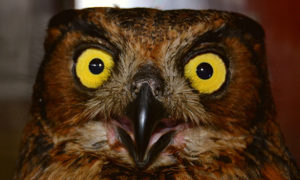
Update: This owl was transferred to a wildlife rehabilitator on November 30 and is doing well.
Featured this week is an adult great horned owl that presented with vision deficits and some concern for an infectious disease called avian pox. Avian pox is a virus that leads to raised nodules on the skin and, in some cases, the inside of the body. The virus itself is not deadly, but the lesions it creates can affect an animal’s ability to see, stand, eat and even breathe. Fortunately, the suspicious nodules that this bird did have are resolving well, so while we can’t rule out pox, he appears to be getting healthy on his own.
As far as his vision is concerned, a previous trauma led to some ocular inflammation, so we are administering anti-inflammatory eye drops and oral medication to help resolve the issue and make him comfortable. He seems to be improving, and after the ophthalmologists recheck him on Wednesday, we’re hoping for a clean bill of health so we can get this bird back into the wild before the end of the year!
—Dr. Nicki Rosenhagen
Red Fox
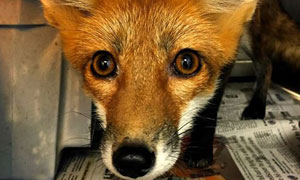
Update: The fox was released Saturday morning, and you can find the (very brief!) video and photos on the Wildlife Medical Clinic’s Facebook page.
Featured on the camera right now is a juvenile red fox. This beautiful animal was transferred to the Wildlife Medical Clinic from a rehabilitation center in Indiana because there was some concern that she might need a corrective bone surgery. The fox was found limping, and a physical exam revealed a broken radius and ulna (the bones of the forearm). Unfortunately, by the time the fox made it the the WMC, the bones had healed at an abnormal angle, which was affecting her ability to walk.
After a consultation with the orthopedic surgeons, they thought she might still be able to get around well without surgery, and they advised allowing the kit to rest for several weeks. Now, three weeks of cage rest later, she’s active, ornery, and moving around pretty darn well! We’re optimistic she’ll do well in the wild, and she’s scheduled to be released within the next week!
—Dr. Nicki Rosenhagen
American Robin
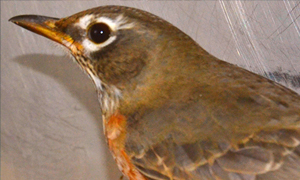
Update: The robin was released back into the wild!
Featured this week on the Wildlife Medical Clinic’s Critter Cam is an adult female American robin. This beautiful bird was brought to the clinic after she was found on the ground unable to fly. After she was given some time to calm down in a dark cage on oxygen, the students observed that her right wing was being held in an abnormal position. A physical exam then confirmed that there was indeed an injury associated with that wing—an injured, likely broken, scapula (shoulder blade). Despite the injury, there is little that we can do to fix this bone other than supportive care, pain management, and cage rest, but the prognosis is generally a pretty good one if there aren’t other injuries and if the animal will eat in captivity. And if you’ve spent any time watching this girl, you may have noticed her hopping in and out of a bin of dirt or sand—it’s full of worms, so we’ve got eating covered! She’s been a great patient so far, and we’re hoping that with a short period of rest (little birds heal very quickly!), she’ll make a full recovery.
—Dr. Nicki Rosenhagen
Barred Owl
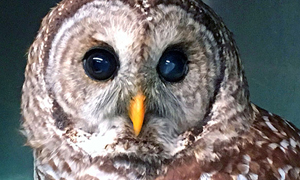
Update: The barred owl is still in care and waiting for his ophthalmic exam recheck appointment in two weeks—but he’s doing well!
This week’s Critter Cam features an adult barred owl in care at the Wildlife Medical Clinic. This unlucky bird encountered two unfortunate foes—a car window and a hawk. The owl was hit by a car, which caused a traumatic brain injury, and THEN took an irritable red-tailed hawk’s talon to the left eye. Aggressive medical management by the students in the clinic saved the bird from succumbing to the brain injury, but unfortunately, the damage to the eye (seen as a white-ish opaque lesion in the photo) will affect her vision for the rest of her life. The good news is that as nocturnal hunters, owls depend more heavily on hearing for finding their prey than diurnal (active during the day) hunters, so some of them can still survive in the wild with less than perfect vision. And that’s what we’re hoping for with her. Once her course of eye medication is complete, we’ll transfer her to a facility that can better assess her ability to navigate in flight and locate prey. And as long as she can pass those tests, she’ll have her second chance in the wild!
—Dr. Nicki Rosenhagen
Peregrine Falcon
![[critter cam - peregrine falcon]](https://vetmed.illinois.edu/wp-content/uploads/2021/04/news-cc-peregrine-300x180.jpg) Update: The peregrine falcon is doing well. Pins from the surgery were removed last week, and the elbow looks good so far!
Update: The peregrine falcon is doing well. Pins from the surgery were removed last week, and the elbow looks good so far!
The Critter Cam is focused on a pretty spectacular species this week: a peregrine falcon. Peregrine falcons are remarkable hunters that can reach speeds of over 200 mph while in a dive toward a meal, earning them the title of fastest animal in the world!
The falcon in care at the Wildlife Medical Clinic was found on the side of a highway, likely clipped by a passing car. She was diagnosed with a fractured radius (the smaller bone in the “forearm”), a fractured scapula (shoulder blade), and a luxated (or dislocated) elbow. It may be surprising to know that the fractures were not really a concern for us; instead, the dislocation was the biggest challenge for this bird’s recovery. In order to fix the luxation (a technique known as a reduction), we put the bird under anesthesia, popped the elbow back into place, drilled metal pins into the humerus and ulna (the big bones the make up the elbow) and connected them together with a hard acrylic to keep the elbow in place while it healed. We’re now two weeks out of surgery, and the pins will be removed this week to assess healing. Keep your fingers crossed!
—Dr. Nicki Rosenhagen
Red-Tailed Hawk
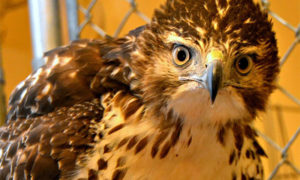 Update: The red-tailed hawk left the Wildlife Medical Clinic to begin flight conditioning at the Illinois Raptor Center. She’s on her way to release!
Update: The red-tailed hawk left the Wildlife Medical Clinic to begin flight conditioning at the Illinois Raptor Center. She’s on her way to release!
This beautiful bird is a juvenile red-tailed hawk that was brought to the Wildlife Medical Clinic after being found down and unable to fly. A thorough physical examination revealed no obvious injuries, but with X-rays, we were able to identify an abnormally large spleen. (The spleen is important for filtering blood and can be enlarged for many reasons, including infection.)
After some discussion, the students decided to perform an endoscopic procedure. An endoscope is a specialized instrument that allows for visualization of the organs in the abdomen, thorax, or, in the case of a bird or reptile, the coelom. With it, we could not only see the spleen up close, but we also had the opportunity to take a biopsy sample to test for a number of possible infectious diseases. The procedure went well, but there were no remarkable findings visually or from the biopsy.
Fortunately, despite a lack of a definitive diagnosis, the bird was getting stronger every day, so the cause of the initial splenomegaly (enlarged spleen) seemed to be resolving. Unfortunately, she also developed a swelling of her right foot that seemed to be from an old injury and was impacting her ability to stand on and use the foot. With antibiotics and time, this bird seems to be using that foot better and the swelling is going down. We moved her to the larger enclosure you see her in now to give her more space to move and stretch. As long as things keep heading in the right direction, she’ll be on her way to an outdoor flight cage in no time!
—Dr. Nicki Rosenhagen
Ruby-Throated Hummingbird
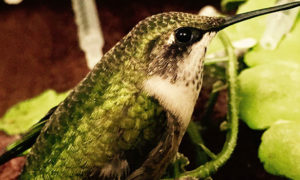 Hidden in this cage among the perches and foliage is a tiny little ruby-throated hummingbird. This little female was brought in to the Wildlife Medical Clinic by none other than a hummingbird bander who found her on the ground, unable to fly. On examination, the students confirmed her inability to fly, but because of her very small wings, they were unable to feel a break in a specific bone. But given the history and what we DID find on the exam, we suspect that she has a fractured coracoid (birds have 2 coracoid bones; they lie below the clavicles—collarbones in a human—and act as struts to protect the chest during the powerful wing beats).
Hidden in this cage among the perches and foliage is a tiny little ruby-throated hummingbird. This little female was brought in to the Wildlife Medical Clinic by none other than a hummingbird bander who found her on the ground, unable to fly. On examination, the students confirmed her inability to fly, but because of her very small wings, they were unable to feel a break in a specific bone. But given the history and what we DID find on the exam, we suspect that she has a fractured coracoid (birds have 2 coracoid bones; they lie below the clavicles—collarbones in a human—and act as struts to protect the chest during the powerful wing beats).
In order for the bone to heal, the best treatment for an animal this small and fragile is cage rest and pain management. In the meantime, we’ll keep her quiet and well-fed until we recheck her flight in 7 to 10 days. (Check out the syringes around the cage filled with a specialized nectar formula; the shape of the syringe allows hummingbirds to drink just like they do from flowers!)
—Dr. Nicki Rosenhagen
Ball Python
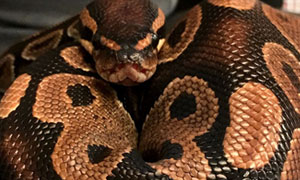
The Wildlife Medical Clinic’s newest education animal is a ball python named Bucket! Bucket came to the clinic when his previous owner (one of the clinic veterinarians) decided he would be a great addition to the program. Ball pythons are native to sub-Saharan Africa. Even though he isn’t an Illinois native, Bucket has already helped kids and adults all around Champaign-Urbana learn about reptiles—in the wild and as pets. Snakes spend quite a bit of time hiding out, but be on the look out, because when it’s near feeding time, and when he gets excited for dinner, Bucket becomes quite active in his enclosure!
—Dr. Nicki Rosenhagen
Great Horned Owl
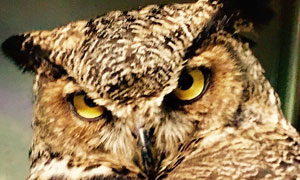
Update: The owl did really well and left for flight reconditioning at the Illinois Raptor Center!
This great horned owl was transferred to the Wildlife Medical Clinic from a nearby raptor (bird of prey) rehabilitation center. On intake, the students noted that she was very thin and weak and was displaying some suspect neurologic signs (her head was tilted to the side and she seemed unsteady). To help determine what was wrong, the students submitted a blood sample for analysis and realized that she was anemic (low numbers of red blood cells), was leukopenic (low numbers of WHITE blood cells), and had signs of a severe parasitic infestation. She has since received fluid and nutritional support as well as an antibiotic. A microscopic examination of her feces confirmed the presence of intestinal parasites, so she has been treated for those as well. This bird still has a long road to recovery, but she’s showing small signs of improvement, so we’ll continue to support her until she’s strong enough for more advanced reconditioning.
—Dr. Nicki Rosenhagen
Fledgling Northern Cardinal
![[critter cam - northern cardinal]](https://vetmed.illinois.edu/wp-content/uploads/2021/04/news-cc-northerncardinal-300x180.jpg) Update: Sad news. The fledgling cardinal passed away unexpectedly.
Update: Sad news. The fledgling cardinal passed away unexpectedly.
The fledgling northern cardinal seen on camera here is quite the late bloomer! The Wildlife Medical Clinic usually sees baby birds through the month of August, but by September, most are out of the nest and independent. But this little guy was found on the ground, all alone in the middle of September. Fortunately, the students caring for him didn’t find any injuries and he seems to be healthy (and has a great appetite!), so we’re providing him some company in the form of a mirror and regular feedings until he grows up a bit and can start flight training at a rehabilitation center. The good news is that even though it’s late in the season, passerines (perching songbirds) grow very quickly, so he should be grown and flying by the end of the month.
—Dr. Nicki Rosenhagen
Juvenile Wild Turkey
![[critter cam - turkey]](https://vetmed.illinois.edu/wp-content/uploads/2021/04/news-cc-turkey-300x180.jpg) Update: As this guy got bigger, turns out he is probably a chicken. They all look alike when they’re little. 🙂
Update: As this guy got bigger, turns out he is probably a chicken. They all look alike when they’re little. 🙂
Caught on camera here is a juvenile wild turkey! This little guy was brought in after he was found alone in someone’s driveway. Turkeys are precocial animals (meaning they are born/hatch with their eyes open and can walk and feed themselves very soon—much like ducks or deer fawns), so while they don’t grow up in a nest like some birds, they shouldn’t be completely alone at this age. Fortunately, he’s generally healthy, but his crop (an outpouching of the esophagus that many birds have to store large amounts of food) was full of hard material that wasn’t being digested by the time he came to us. For now, we’re managing the problem by providing lots of fluid to try and rehydrate him and the ball of food, and based on his attitude and the progress so far, we’re optimistic that it will resolve soon.
(You may notice a mirror on camera, too. We use mirrors to give some “company” to solitary young animals. The animals often take to the mirrors—and sometimes stuffed animals—quite well, snuggling up beside the apparent friend. This helps to keep their stress levels down and shows them what a member of their species looks like!)
—Dr. Nicki Rosenhagen
Cooper’s Hawk
![[Cooper's hawk - critter cam]](https://vetmed.illinois.edu/wp-content/uploads/2021/04/news-cc-coopershawk-300x180.jpg) This Cooper’s hawk was brought in after a kind Samaritan found her on the ground, unable to stand. The physical exam revealed no obvious abnormalities, so she was started on an anti-inflammatory drug in the event that the cause of the problem was a spinal injury. She was rehydrated, offered food, and allowed to rest and recoup. Several days after intake, the hawk was seen weakly standing, and within a week, she was up and apparently normal! You may see her bouncing around her cage, and this is totally normal in this species. Cooper’s hawks are notoriously high energy and do not tolerate captivity well, but this energy serves them well as they are incredibly agile fliers and hunt their prey (usually songbirds) by pursuing them through forests and vegetation. Next week, this bird will leave the hospital for some very short flight reconditioning and then be released back into the wild!
This Cooper’s hawk was brought in after a kind Samaritan found her on the ground, unable to stand. The physical exam revealed no obvious abnormalities, so she was started on an anti-inflammatory drug in the event that the cause of the problem was a spinal injury. She was rehydrated, offered food, and allowed to rest and recoup. Several days after intake, the hawk was seen weakly standing, and within a week, she was up and apparently normal! You may see her bouncing around her cage, and this is totally normal in this species. Cooper’s hawks are notoriously high energy and do not tolerate captivity well, but this energy serves them well as they are incredibly agile fliers and hunt their prey (usually songbirds) by pursuing them through forests and vegetation. Next week, this bird will leave the hospital for some very short flight reconditioning and then be released back into the wild!
—Dr. Nicki Rosenhagen
(Note: The photo is actually of a Cooper’s hawk that was treated about 15 months ago at the Wildlife Medical Clinic. According to Dr. Rosenhagen, these birds are “absolutely nutty animals, so getting a photo without getting attacked has proved…difficult.”)
Red-Tailed Hawk
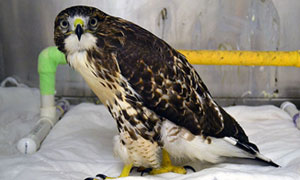
This juvenile red-tailed hawk was brought to the Wildlife Medical Clinic unable to fly, and after x-rays were taken, we realized the bird had an old ulna fracture (the bone between your pinky and elbow). Fortunately, the fragments were very well-aligned and the radius (the other bone in the forearm, between the thumb and the elbow) was intact. Having the radius intact provides a natural splint for the wing and improves the chance of the bone healing well, so we were able to simply apply a bandage to the wing and cage rest her to let the bone heal on its own—which it’s doing marvelously! This bird is nearly ready for her pre-release conditioning, which will hopefully begin next week.
—Dr. Nicki Rosenhagen
Baby Fox Squirrel
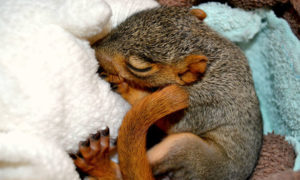 The baby seen above is an approximately four-week-old fox squirrel. She was brought to the Wildlife Medical Clinic after she was found alone on the road, likely having fallen from her nest. Often when this happens, the finders can either return healthy babies to the nest if it’s accessible or leave them in a safe, nearby area (sometimes this is in the form of an artificial nest made out of Tupperware or a box) and mom will come and carry them home. Unfortunately for this little girl, her fall led to some serious injuries that required medical attention—including what looks like a broken hind leg. We’ll have x-rays taken to let us know for sure, but in the meantime, she’s getting regular syringe feedings with specialized formula as well as some pain medication.
The baby seen above is an approximately four-week-old fox squirrel. She was brought to the Wildlife Medical Clinic after she was found alone on the road, likely having fallen from her nest. Often when this happens, the finders can either return healthy babies to the nest if it’s accessible or leave them in a safe, nearby area (sometimes this is in the form of an artificial nest made out of Tupperware or a box) and mom will come and carry them home. Unfortunately for this little girl, her fall led to some serious injuries that required medical attention—including what looks like a broken hind leg. We’ll have x-rays taken to let us know for sure, but in the meantime, she’s getting regular syringe feedings with specialized formula as well as some pain medication.
The good news is that babies grow quickly, and injuries that would require surgery or at least several weeks to heal in an adult take much less time in babies, and they can often make a full recovery with little more than rest and good nutrition. So far this little girl is doing well, and we’re hopeful she’ll continue to heal. Keep an eye on her snuggled up to her stuffed animal friend and you may even catch her dreaming!
—Dr. Nicki Rosenhagen
Barred Owl
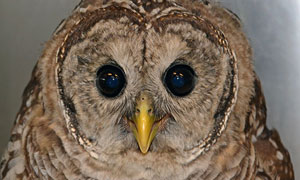 Update: The barred owl continues to do well and is having repeat x-rays on Friday, Aug. 26, to assess healing. We’re hoping to remove the pins from the wing in the next two weeks or so and start pre-release conditioning at a nearby rehabilitation center.
Update: The barred owl continues to do well and is having repeat x-rays on Friday, Aug. 26, to assess healing. We’re hoping to remove the pins from the wing in the next two weeks or so and start pre-release conditioning at a nearby rehabilitation center.
The barred owl seen above was brought to the Wildlife Medical Clinic unable to fly. On examination, it was noted that the major and minor metacarpal bones of the right wing (equivalent to the hand bones in a mammal) were both broken. After the bird was stabilized with fluids and pain control for a few days, we took him to surgery to fix the fractures. Surgery went well, and we were able to place pins into the broken bones to hold them in a normal position while the body heals. The bird is doing very well post-op—he receives range of motion and laser therapy on a regular basis, and no longer needs a splint to hold the wing up. He’s also eating, perching, and behaving just like a normal barred owl should—which means lots of beak clacking and posturing towards his human caretakers!
—Dr. Nicki Rosenhagen
Seven Baby Opossums
![[critter cam - baby opossums]](https://vetmed.illinois.edu/wp-content/uploads/2021/04/news-cc-opposums-300x180.jpg) Update: The opossum babies went to a rehabilitator on Wednesday, Aug. 17. They are doing great!
Update: The opossum babies went to a rehabilitator on Wednesday, Aug. 17. They are doing great!
In the spotlight this week is a litter of orphaned Virginia opossums. (One guy was being fed when we took the photo. That’s why there are only six in the picture.)
These little guys were rescued by a kindhearted stranger who found them clinging to their dead mother. They all appear to be healthy, but because they were nursing from mom after she died, we started them on antibiotics to prevent infection. After the course is completed, they will be transferred to a licensed rehabilitator, where they will finish growing before their release this fall. Because opossums are marsupials and grow up in a pouch, we offer them a cloth replacement to make them feel more at home. So when they sleep, they may be out of sight, tucked away in their new home, but keep an eye out because they’re starting to explore the outside world!
Opossums often get a bum rap, but it’s usually based on false information. Opossums rarely carry rabies (as marsupials, their body temperature is actually lower than what the virus likes), they are vital scavengers (read: clean-up crew), and they are important defenders against Lyme disease. Despite their somewhat unkempt appearance, opossums are actually incredibly efficient groomers, and as such, they consume more than 90% of the ticks that jump on board (some claim this can be upwards of 4,000 ticks per week!). As a result, they help control the infected ticks that can affect humans and their pets. So the next time you spot an opossum in the road, the forest, or even in your backyard, give him a nod of respect for a job well done.
—Dr. Nicki Rosenhagen
Great Blue Heron
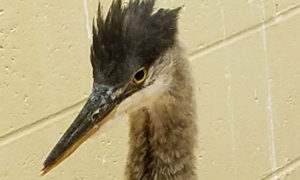 Update: Sadly, the great blue heron died on August 14.
Update: Sadly, the great blue heron died on August 14.
Many birds living in central Illinois are recognizable when viewed up-close or on the ground, however very few birds are as recognizable in flight as the great blue heron. These large birds have an impressive wingspan of up to seven feet and can fly 20 to 30 miles per hour, with their slow wingbeat, head pulled back over their shoulders, and legs trailing behind being reminiscent of prehistoric birds.
This great blue heron was observed on a bridge in Thawville, Ill. (Iroquois County), early one morning. While that wasn’t unusual, the fact that it was still in the same spot that evening was. Realizing that something was wrong, a rescuer corralled the heron into a pet carrier to transport to the Wildlife Medical Clinic. Great blue herons often forage for food in shallow water on long, thin legs, using their spear-like beak to catch their prey. It’s no surprise that our rescuer had to avoid being “speared” by this bird in transit!
The heron was examined and found to have multiple severe fractures of the bones at the end of its right wing (major and minor metacarpals) and at its wrist (distal ulna). It also had cracked the tip off its bill and had an eye injury. This flying dinosaur was definitely grounded; but careful evaluation of the injuries and consultation with the Veterinary Teaching Hospital’s ophthalmology service has us hopeful that we can get this heron back in the sky. The injured wing is being maintained in a figure-8 bandage and anti-inflammatory eye drops will help prevent permanent vision loss in the affected eye. Already feeling better, this great blue heron is full of antics and raucous calls anytime we come near.
—Dr. Julia Whittington, Wildlife Medical Clinic Director
Turkey Vulture
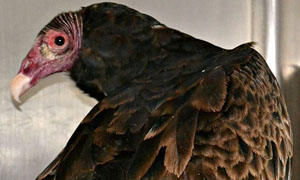
Seen here is an adult turkey vulture that the students at the Wildlife Medical Clinic are caring for. This bird had been hanging around a kind Samaritan’s house for the better part of a month before she was able to catch him and bring him to the clinic for medical attention. A thorough physical exam and x-rays revealed an old, poorly healed fracture of his left humerus (the bone between the shoulder and the elbow—you may be able to see it dropping in the video.) His injury is eerily similar to that of a juvenile bald eagle that the WMC repaired earlier this year! However, while the bald eagle required a fairly advanced surgical repair, it seems as if the conformation of the bone on the vulture isn’t quite as severe, so we’re attempting to rehab this animal using controlled physical therapy of the shoulder. If this fails to get the bird flying, then we will likely explore surgical options.
—Dr. Nicki Rosenhagen
Groundhog
![[groundhog]](https://vetmed.illinois.edu/wp-content/uploads/2021/04/news-cc-groundhog-300x180.jpg)
Update: Critter Cam didn’t stay on the groundhog for very long. Apparently, she was “feeling much better and chewed the Nestcam cord to pieces (even though we taped it up near the roof of her cage….),” reported Dr. Nicki Rosenhagen. In fact, she destroyed two cords in less than two days, leading to the realization that she was ready to be released! And so, she is back in the wild now.
Caught on camera here is a groundhog (also known as a woodchuck or a whistlepig) in care at the Wildlife Medical Clinic. This girl was brought in last week after she was hit by a car. On presentation, she was obtunded (mentally dull, not alert) and weak, so the students placed an IV catheter and initiated treatment for suspected traumatic brain injury. The groundhog also received some pain medication and fluid therapy. Within a day, she was brighter and a little more alert, and she eagerly ate the slurry diet we syringe fed to her. Typically, adult groundhogs are very resistant to handling and can be aggressive and dangerous to anyone who gets too close. So despite not finding any major external injuries, the fact that she was still not fighting much when we handled her indicated that we weren’t yet out of the woods. Over the weekend though, she seems to have turned a corner. She’s vocalizing angrily when we’re around and she even tried to bite (bad news for us—but we’re happy to see she’s feeling better)! We’ll plan to keep her at least a few more days to make sure she continues to improve, but hopefully by the week’s end she’ll be back out in the wild, chucking all the wood she can chuck!
—Dr. Nicki Rosenhagen
Raccoon Kit
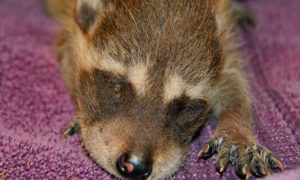 Above, you see what appears to be two stuffed animals in a cage. Look closer, and you’ll realize that one is actually a little (live!) raccoon kit. Unfortunately, the dog that found this baby also thought he was a toy, and while playing, the pressure from her mouth created two abdominal wall hernias on her new raccoon friend. Hernias are defects in muscle or connective tissue around body cavities—they can be from abnormal development like an umbilical (belly button) hernia or from trauma. In this raccoon’s case, the squeezing from the dog caused a break in the abdominal muscles (but not the skin) which created a pocket for things like fat and intestines to slip into. Hernias can be incredibly dangerous if important organs get stuck in them, but in this animal’s case, the defects are big enough to not cause immediate danger. But even though they aren’t causing any problems right now, they still need to be corrected for this animal to live a normal life in the wild, and since the dog’s owner was kind enough to bring the raccoon to the Wildlife Medical Clinic, this animal can now receive the treatment he needs.
Above, you see what appears to be two stuffed animals in a cage. Look closer, and you’ll realize that one is actually a little (live!) raccoon kit. Unfortunately, the dog that found this baby also thought he was a toy, and while playing, the pressure from her mouth created two abdominal wall hernias on her new raccoon friend. Hernias are defects in muscle or connective tissue around body cavities—they can be from abnormal development like an umbilical (belly button) hernia or from trauma. In this raccoon’s case, the squeezing from the dog caused a break in the abdominal muscles (but not the skin) which created a pocket for things like fat and intestines to slip into. Hernias can be incredibly dangerous if important organs get stuck in them, but in this animal’s case, the defects are big enough to not cause immediate danger. But even though they aren’t causing any problems right now, they still need to be corrected for this animal to live a normal life in the wild, and since the dog’s owner was kind enough to bring the raccoon to the Wildlife Medical Clinic, this animal can now receive the treatment he needs.
—Dr. Nicki Rosenhagen
Painted Turtle
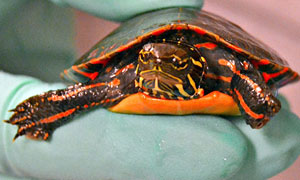 This little painted turtle started out his summer with an unfortunate encounter with a lawn mower. Luckily, the mower’s operator noticed the injured turtle and brought him to the Wildlife Medical Clinic for care. On intake, we realized that this poor guy had a near complete traumatic amputation of his left forearm. Both bones in the arm were broken and the muscle and connective tissue in the area was damaged beyond repair. Despite his injury, the turtle was very feisty and active, so once he was stable enough for surgery, we put him under anesthesia and completed the amputation, making sure to clean out the dead bone and tissue so that the stump would heal. The turtle recovered from the procedure without incident and has been using the limb to swim and walk almost normally. He’s finished his course of antibiotics and is still looking great, so we’re hoping he’ll be back out in the wild before the end of the month!
This little painted turtle started out his summer with an unfortunate encounter with a lawn mower. Luckily, the mower’s operator noticed the injured turtle and brought him to the Wildlife Medical Clinic for care. On intake, we realized that this poor guy had a near complete traumatic amputation of his left forearm. Both bones in the arm were broken and the muscle and connective tissue in the area was damaged beyond repair. Despite his injury, the turtle was very feisty and active, so once he was stable enough for surgery, we put him under anesthesia and completed the amputation, making sure to clean out the dead bone and tissue so that the stump would heal. The turtle recovered from the procedure without incident and has been using the limb to swim and walk almost normally. He’s finished his course of antibiotics and is still looking great, so we’re hoping he’ll be back out in the wild before the end of the month!
—Dr. Nicki Rosenhagen
Snapping Turtle
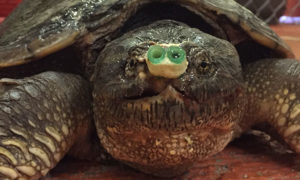 Seen here is an adult snapping turtle that had been hit by a car and presented with multiple shell fractures and a fracture to the maxillary beak (upper part of face). After flushing and cleaning the wounds to the shell, the fractures were filled with calcium hydroxide paste and coated in epoxy to make them waterproof. Due to the injury to the face, the veterinarians were worried that newly forming tissue would close over the turtle’s nares (nostrils), preventing him from breathing through his nose.
Seen here is an adult snapping turtle that had been hit by a car and presented with multiple shell fractures and a fracture to the maxillary beak (upper part of face). After flushing and cleaning the wounds to the shell, the fractures were filled with calcium hydroxide paste and coated in epoxy to make them waterproof. Due to the injury to the face, the veterinarians were worried that newly forming tissue would close over the turtle’s nares (nostrils), preventing him from breathing through his nose.
The clinic director was innovative and inserted soft catheter tips into the nares to allow him to breathe during the healing process while providing a barrier to keep the healing tissue from covering the nostrils. Turtles are notorious for not eating while in captivity, so an esophagostomy tube (a tube going directly into the stomach) was also placed during the procedure. This allowed us to feed a liquid diet to the patient so he would have the energy he needed to recover! Since the initial surgery, both the feeding tube and the catheter tips have been removed. Turtles have keratin scales over the top of their boney shells, so as he grows and sheds, the epoxy on the shell will also naturally shed.
This snapper is well on his way to recovery; we are just hoping to catch a glimpse of him eating to be sure he can hunt before he is released back into the wild.
—Dr. Nicki Rosenhagen
Coyote Pup
Update: The coyote pup left for rehab on Monday, July 18, where he will receive longer term care in larger, outdoor caging with a rehabilitator. His anemia had resolved, his parasites cleared up, he was putting on weight, and he was eating/behaving normally.
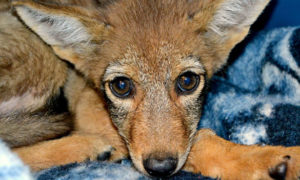 A young coyote pup was admitted to the Wildlife Medical Clinic on Sunday, July 10. The pup had been cornered by several dogs, and while he was not injured, he was clearly alone and unhealthy. A physical exam and some basic bloodwork revealed that the coyote was severely dehydrated, underweight, and anemic. (He had a critically low number of red blood cells.) We also realized that he had a heavy intestinal parasite load—the most likely reason for the anemia and poor body condition. Fortunately, the emergency service had donated some canine blood to the WMC, so this lucky pup received dewormer treatment for his parasites, intravenous fluids for his dehydration, food for his belly, and a blood transfusion for his anemia. Since the original treatment, he’s perked up, he’s eating, his blood cells are regenerating, and he’s even chewed out his IV catheter (twice!). Coyotes can be very calm and quiet in captivity, but don’t let that fool you; this little guy is on the mend and feeling much better!
A young coyote pup was admitted to the Wildlife Medical Clinic on Sunday, July 10. The pup had been cornered by several dogs, and while he was not injured, he was clearly alone and unhealthy. A physical exam and some basic bloodwork revealed that the coyote was severely dehydrated, underweight, and anemic. (He had a critically low number of red blood cells.) We also realized that he had a heavy intestinal parasite load—the most likely reason for the anemia and poor body condition. Fortunately, the emergency service had donated some canine blood to the WMC, so this lucky pup received dewormer treatment for his parasites, intravenous fluids for his dehydration, food for his belly, and a blood transfusion for his anemia. Since the original treatment, he’s perked up, he’s eating, his blood cells are regenerating, and he’s even chewed out his IV catheter (twice!). Coyotes can be very calm and quiet in captivity, but don’t let that fool you; this little guy is on the mend and feeling much better!
—Dr. Nicki Rosenhagen
[/toggle][/toggleset]

![[juvenile bald eagle]](https://vetmed.illinois.edu/wp-content/uploads/2021/04/cc-juv-eagle.jpg)
